Lexington, Ky.—Nov. 13
Good jumping comes from good flatwork—have truer words ever been spoken to an equestrian?
The old wisdom held as true as ever on Day 2 of six-time British Olympian Mary King’s clinic in Lexington, Ky. The veteran four-star event rider reminded riders of the lessons learned in Saturday’s flatwork, and built on them for Sunday’s over fences exercises. King asked virtually all of the riders on Sunday the same series of over-fences questions, and different challenges popped up for different pairs.
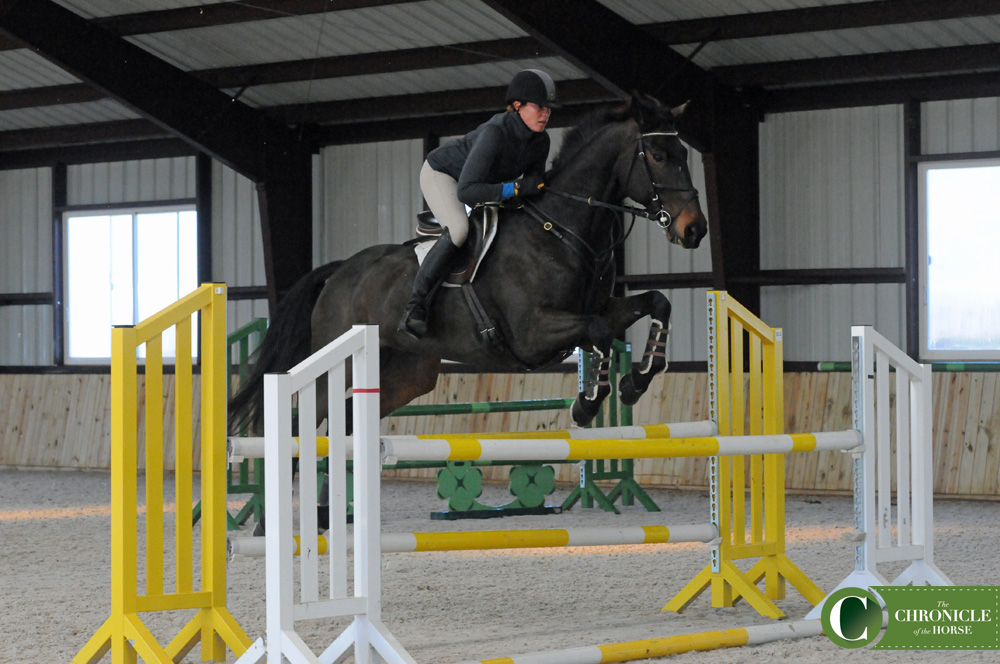
Elissa Gibbs guided Fernhill Super Hero through the triple combination. Photo by Ann Glavan.
A Meaningful Warm-Up Exercise On The Flat
All of the riders started out their session by lengthening and shortening the canter stride while riding a specific pattern of circles throughout the arena. Essentially, King asked each rider to pick up the counter-canter on the quarter line, canter down the quarter line, and at the end of the ring collect the canter and do a circle on the counter lead before lengthening the canter on the straight side of the arena again (we took a short video clip of rider Elissa Gibbs completing the exercise to give you a visual).
“I got this exercise from Lars Sederholm,” King said, referring to the Swedish trainer. “It was incredible, he had a mind full of these different exercises, and he was quite specific about the warm-up, and this is one of his exercises that has stuck in my mind.”
King insisted on seeing a dramatic difference in the canter between the long and short straight sides of the arena and the collection on the circle—she pushed Gibbs to show more pace in her lengthening.
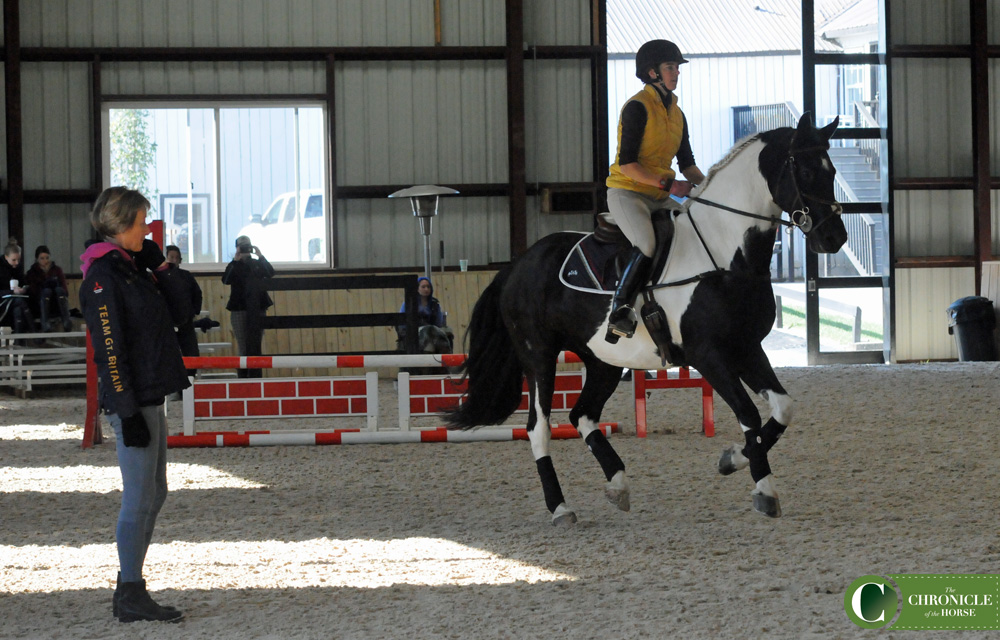
Ellie Celarek cantered toward the out of the combination at an angle, an excercise King said she does often with her horses at home. Photo by Ann Glavan.
Rider Ellie Celarek did a good job of showing a large difference in her two canters, but her Friesian-cross mare kept wanting to swap leads when Celarek would push her into a more forward canter on the long straight sides. King did not want Celarek to slow down or show less of a difference in the canters to address this issue.
“Keep her shape in the extension to hold the lead,” King said, directing Celarek to keep a solid feel on the mare as she asked her to lengthen. Celarek was then able to demonstrate several extensions without the swapping.
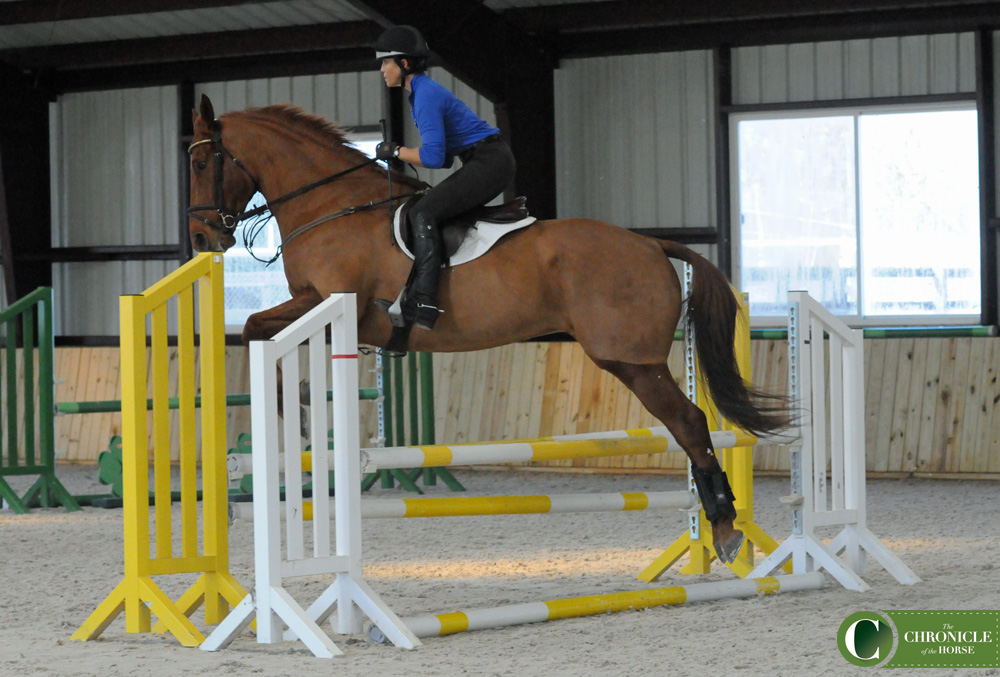
Holly Shine sliced the oxer in the middle of the triple combination. Photo by Ann Glavan.
ADVERTISEMENT
Jumping Position Is Key
The next exercise King had all of her riders do was simply trot and canter over a small cross rail that she raised into a 2’6″ to 3′ vertical after a few jumps, and she told riders she wanted to see what their position was like and observe their style over fences.
“We’re meant to be up top helping our horses, but often we end up hindering them!” King said with a laugh.
“I’m one for watching a lot of the great show jumping riders—Marcus Ehning, Scott Brash, Ben Maher—I watch them and I try to copy what they do. I pretend I’m them when I’m going around a course,” King said. “Like Ben Maher—you barely see his upper body move. He jumps a massive fence this high and hardly moves his upper body. We tend to think we need to move our upper body more than we do.”
King also emphasized in particular the importance of a solid position on cross-country—she said it was extremely important riders keep their lower leg tight and at the girth, not allowing it to fall behind them at all over a fence, because that was when riders got into trouble and fell off. She told a story about fellow British eventer Andrew Nicholson, someone whose stickability and position King admires, to illustrate her point.
“Andrew was catch riding this horse at Punchestown in the three-star one year that had issues with the water,” King recalled. “And we all went out on course to see how he would get through it, because it was a stone wall into a pond, and then another stone wall in the middle of the water and another wall out. It was quite an eyeful to ride down on.
“He got that horse over the first wall, and at the second wall the horse didn’t want to go, and it hung a front leg on the wall,” King continued. “The horse’s hind legs went way up in the air, and they disappeared for a moment on the other side of the wall. We couldn’t see them, we thought he had fallen. Then up they pop, Andrew is still on the horse, and he goes to his stick and they get out over the third wall!”
After addressing any minor issues she saw with rider’s position over the cross rail and small vertical, King had riders start figure-eighting through the outs of the triple one-to-one stride combination set up down the center line. Riders were asked to jump the A and C elements of the triple on a figure eight pattern (we took a short video of Gibbs working through the exercise to illustrate). After successfully completing that exercise, King also had riders figure eight over just the B element, the oxer.
“I like to jump things at different angles with my horses at home, to get them used to it,” King said. King also asked each rider how good they were at switching their whip from hand to hand while on course, because she wanted them to carry their crop on the inside shoulder of their horse on the figure eight to use if their horse thought about ducking out.
“I’m always very aware of what hand I’m carrying my whip in, especially with young horses,” King said. “It can make all the difference if they jump something new on the first time or not, and I carry a whip on every horse I ride, and I switch my whip hand probably five or six times on cross-country whether it’s with a baby on pre-novice or at Rolex.”
Use of the whip became particularly important with Celarek—her mare wanted to run out a couple of times instead of jumping the fences at an angle, and King was adamant that Celarek dig in and get the job done.
“You’re being pretty, she needs you to be brave and forward,” King called out across the ring as Celarek went through the exercise. King explained that when doing this figure eight, it was easy for riders to think backwards and start pulling, because they think that will help hold their horse on the line they are riding.
“It’s like dressage, if you ride forward down the center line, you’re much more likely to go straight than if you’re pulling,” King said.
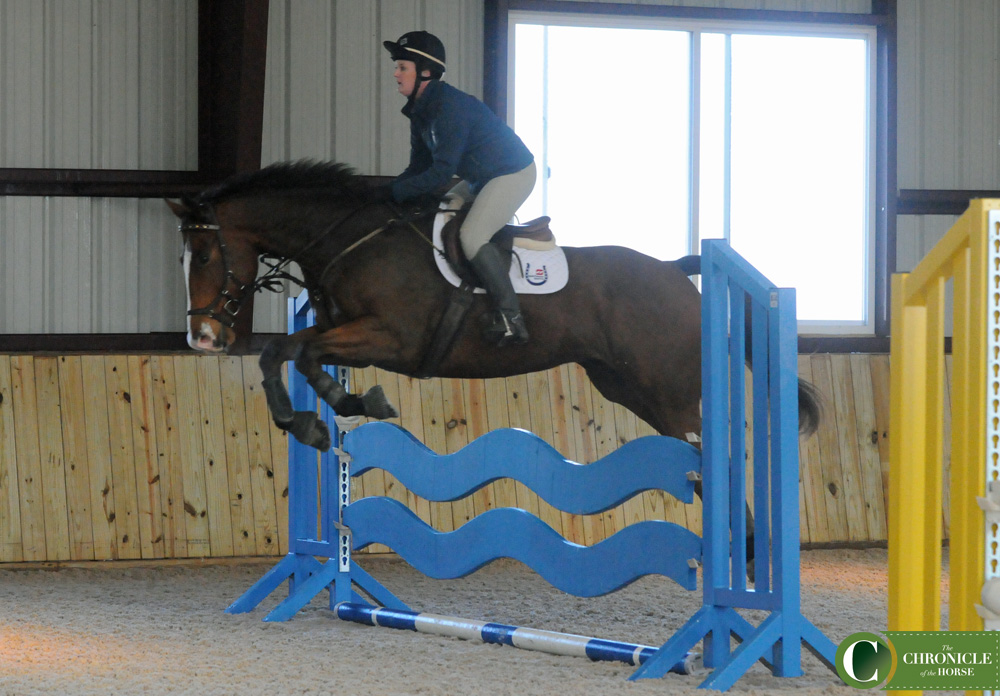
Chelsea Smith tackled the full course with her OTTB. Photo by Ann Glavan.
ADVERTISEMENT
On To The Course Work!
After riders were able to complete the figure eight over the outs and middle of the combination, King put together a short course combining more traditional fence approaches with the slices and angles riders had just worked on. King also had riders jump down the triple combination in its entirety.
Indoor arenas tend to make even the most accurate rider see shorter spots to the fences, and most every rider in the clinic found a couple of deeps spots to something on course.
“When we get deep, we are tempted to just say ‘Help!’,” King said. “That’s exactly when the horse needs your help to try. He needs your shoulders back to stay out of his way so he can get his front legs up, and he needs your leg to keep the power.”
King encouraged riders on younger or green horses not to protect them at the fence. King directed Gibbs in particular not to hold on to her mount’s mouth at the fence so much.
“I know you said you want to help him have a better shape over the fence, but don’t hold his mouth,” King said. “I would rather him have the fence down because your rein was soft and he made a mistake than have you protecting him. Don’t try to protect him when he’s deep, let him learn. You come on a good line with a good canter and it’s up to him to jump the fence well.”
Celarek’s mare, on the other hand, was having issues moving out enough in the lines and the triple combination to get the stride done. King spent a good bit of time working through the issue with Celarek, and advised more work on the flat at home to get the mare truly listening to her leg.
“She needs to go, and not from your voice, she needs to react to your leg,” King said. Celarek, like many riders in the clinic, clucked and voiced forward commands to her mount. King said she wanted to hear less clucking and more response to the leg aid, because the mare needs to go forward to make it down the lines.
“At home, teach her to open up her body,” King said. The mare had no problems showing a nice collected canter, but King wanted to see her more able to demonstrate the other end of the spectrum. “Keep the height of the combinations low, but leave the distances at their proper length, she needs to learn to stretch out and over.”
Clinic rider Holly Shine had no problem with the warm-up figure eight exercise or the triple combination, but she did have issues when jumping the course getting a little bit stuck in the turns. King used German show jumping rider Marcus Ehning as an example to help Shine navigate jumps out of a short corner more smoothly.
“Marcus Ehning is just remarkable to watch ride, he creates all of this energy in the horse underneath him, and then he sits very quiet on top,” King said. “And it’s the way he rides the corner on the way to the fence, keeping that energy, and he’s able to just find the jump very smoothly.”
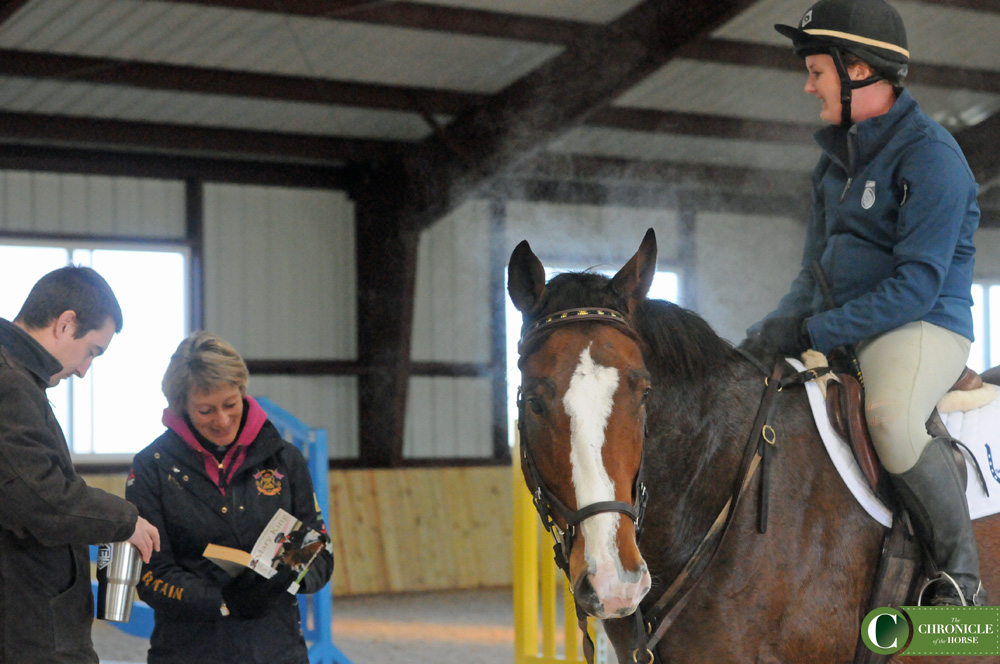
Mary King signed a copy of her autobiography for clinic rider Chelsea Smith. Photo by Ann Glavan.
King referenced a number of great riders she enjoys watching, but she is of course a legend herself in the sport of eventing, and those in attendance at the clinic didn’t forget that. A few riders and auditors brought copies of King’s autobiography, and copies of her newer book “My Way: How I Train For Success,” for King to sign. King was more than happy to oblige and pose for pictures after her sessions, and a couple of lucky riders who went to dinner with King on Saturday night even got a selfie with the Olympian! All in all, a good weekend of educational sport!
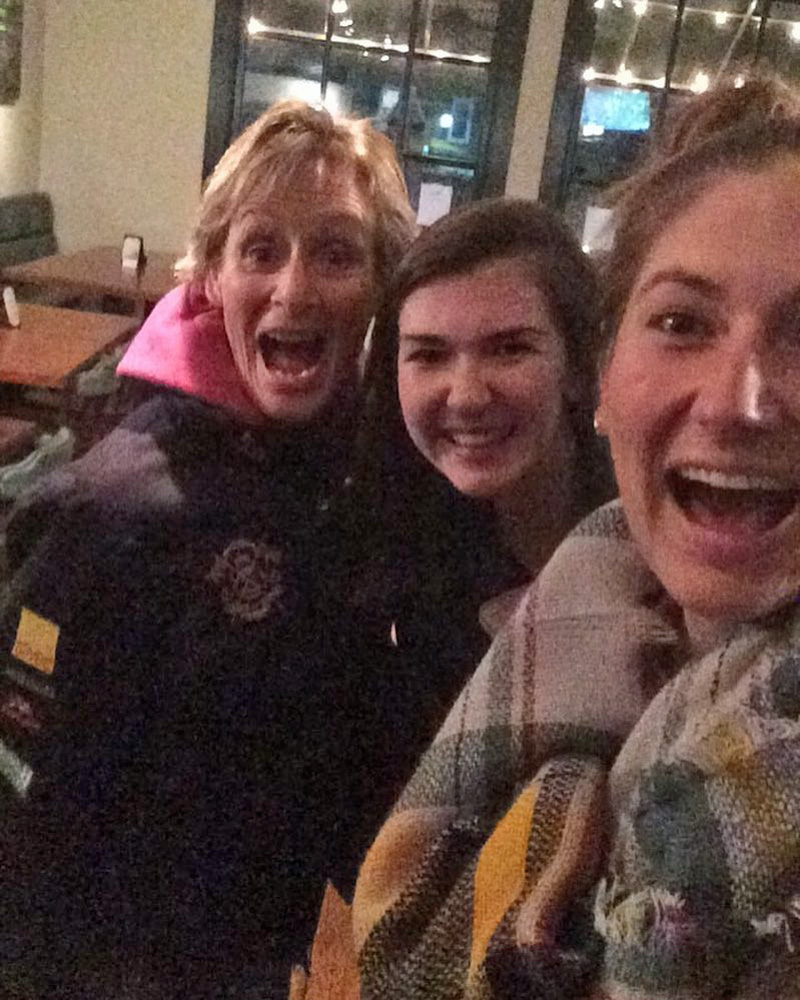
Mary King selfie! From left, King, Erin Johnson and Alexa Ehlers.














